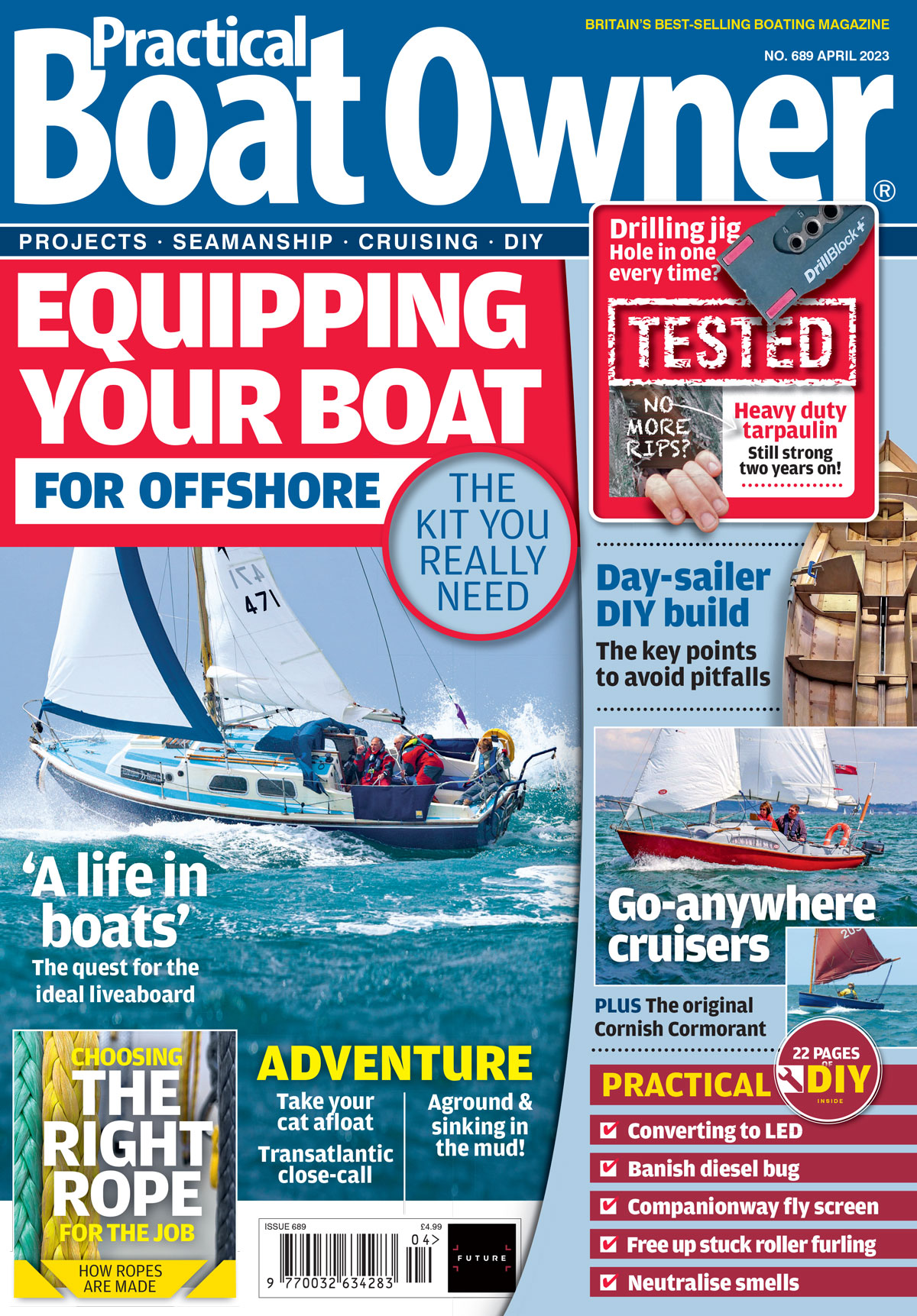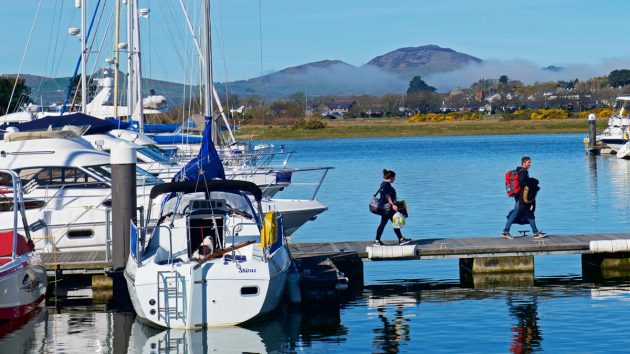Rupert Holmes shares top tips on how to avoid the dangers of falling in while in a marina and how to recover someone from a pontoon
Man overboard: how to recover someone from a marina
How many of us have fallen into a mindset where we consider rowing out to a mooring in a tender as potentially dangerous, but regard strolling down to a boat in a marina berth as a more or less risk free option?
Over the years I’ve chanced upon many situations in which I’ve found someone in the water.
One of the most memorable was waiting for the last Red Jet ferry of a bitterly cold November night at Southampton Town Quay many years ago.
When about 50m from the back of the queue, I heard a faint but persistent cry of “Help! Help!”
Running towards the source it got progressively louder and appeared to be coming from a tug boat whose usual moorings at that time were on the quay.

boatfolk marina staff fine tuning their safety training, practicing man overboard recovery
On reaching the boat I found a crew member hanging from one of the warps, soaking wet after having fallen in when attempting to step on board from the pontoon.
He was clearly properly cold and I’ve never seen anyone look more frightened.
We quickly helped him on board, though he refused all offers of medical help.
It was an important lesson in many respects, not least of which is to never give up hope, however desperate the circumstances.
Despite being very cold, with no one obviously nearby, he was continuously yelling at the top of his voice.
It’s sobering to think without that dogged perseverance he may have perished.
I’ve also encountered people falling between gaps in pontoons or late at night when lighting is poor, which has the potential to be disastrous in a tidal marina.
Marina man overboard: Passerelle plunge
A more common problem is people falling off planks or passerelles while boarding a boat moored stern to in the Mediterranean.
This might at first appear to be less of a problem, thanks to higher water temperatures.

Crewsaver’s Rescue Sling has a pre-shaped design to aid recovery
However, it can be scarily cold early in the season, while a further potential problem is that you’re falling from a height, albeit a modest one, which means there’s a risk of head injuries.
Another situation I’ve met more than once, is that of a strong wind blowing off a pontoon when a boat is attempting to come alongside.
It’s often assumed that stepping ashore in such a situation is an unavoidable risk, but there are much better alternatives.
Tip for coming alongside
If it’s a long pontoon at the edge of a channel you can simply reverse up to it, get a stern line attached and then warp the boat into position.
If it’s a finger berth in a marina, then accept that you may be blown onto the neighbouring boat downwind and arrange fenders in an appropriate fashion.
We all seem to have too much of a tendency to always expect to step off onto a pontoon.
Continues below…
PBO Tested: 17 lifejackets
Five dedicated testers took to the RNLI College's training pool to put 17 lifejackets through their paces.
Man Overboard – using a lifesling
Using a lifesling to make contact with and recover a man overboard.
MOB retrieval: an easy way
A large purchase system might be the key
What safety kit do you need for watersports?
Having the right safety kit for watersports is essential. I kayak every day and I also have a small motorboat…
While that made sense when boats were smaller and had relatively low freeboard, there are countless situations now where the best approach is to lasso a cleat in the same manner as the crew of large motor yachts and catamarans.
This is a far safer option that eliminates the need to step ashore until the boat’s safely secured, even if only temporarily.
My own near miss was as a Yachtmaster Instructor, when I tripped while stepping ashore with mooring lines.
I landed on the pontoon, but only just.
Ever since then I’ve never stepped off a boat that’s still moving towards the dock and always make a point of briefing crew to be similarly cautious.
Slippery conditions
Frosty weather and snow are particularly dangerous in a marina, when the only safe option may be to wear spiked or studded soles that fit over shoes rather like crampons, like the Due North Everyday G3 Ice Cleat (below) available at Amazon.co.uk and from other suppliers.
It’s also worth remembering that wet conditions on a pontoon that has algal or other organic growth on it can also be equally lethal.
I’ve long been of the opinion that many pontoons would be safer with decent toerails added.
Note: We may earn a commission when you buy through links on our site, at no extra cost to you. This doesn’t affect our editorial independence.

Studs for walking in snow and ice are also effective on slippery pontoons
This alone would prevent most instances of someone sliding over the edge in slippery conditions.
I’m normally hesitant to recommend plastic pontoons over a renewable option such as timber, but having said that some plastic surfaces developed for marina pontoons have amazing non-slip properties in almost all conditions.
Man overboard rescue response
What happens if someone does fall in? Marinas ought to have regularly placed lifebuoys, ladders and other essential equipment, but even when well sign-posted these can be difficult to locate in the heat of the moment, especially at night.
Fortunately your own boat, and others nearby, are likely to be equipped with easily accessible kit designed specifically for this kind of emergency.

Nereus 25m rescue line in throwing sock – vital kit for a man overboard
In a tidal marina it’s important to get a line to them immediately, so that they’re not swept under a pontoon, or even worse, into open water.
A standard floating heaving line in a bag, such as the Nereus 25m Rescue Line In Throwing Sock, will do the job here.
Remember that, even with practice, it’s difficult to throw them accurately over a distance of more than around 5-6m from the deck of a yacht or a pontoon.
Casualty tip
As an aside, it’s important to know the best course of action if you’re in the water and have been thrown a line.
Our natural instinct is to hold it out in front, with arms outstretched, but that risks being pulled along with your mouth and nose under water.
The correct approach is therefore to turn on your back, with the rescue line leading over one shoulder.
Your face will then be above the water while you’re being pulled to safety.
If contact cannot be made with the casualty using a rescue line, then your boat may have lifebuoys with lights (and a drogue) that can be thrown towards the casualty.
Even if it doesn’t reach them it will mark their position. I strongly prefer the more expensive sealed-for-life type of lights, such as the Ocean Safety Apollo Horseshoe Set, which are far more reliable than the type that use torch batteries.
Look for ladders
Most marinas have decent ladders, but these can be hard to find and to reach, especially in the dark, or if there’s a tidal stream running.
I try to make a mental note of where they are but have to admit to not always being as diligent as possible in this respect.
Fortunately, many boats have decent boarding ladders that an able-bodied person can use to haul themselves out of the water, even if a passer-by is needed to lower it.
When dealing with an unconscious casualty, or someone who lacks strength, in many cases two people will be able to lift them high enough to roll them onto the pontoon.
However, if needs be, the casualty could be hauled out of the water using a lifesling attached to a spinnaker halyard; the Crewsaver Rescue Sling has a pre-shaped design to assist recovery.
Spinlock Alto

We all know that wearing a lifejacket dramatically increases your chances of survival, yet few of us wear one on marina pontoons, even late at night.
This is one of the scenarios for which Spinlock developed this product – it’s an automatically inflating horseshoe lifebuoy in a compact bag (£50)that can be worn on a belt.
It’s easy to carry – a very simple idea but one that stands to save lives.
Ocean Safety Advice
Ocean Safety specialises in the supply, distribution, and hire of marine safety equipment.
Managing director Alistair Hackett said: “Being able to retrieve a person from the water as quickly as possible is paramount as the risk of hypothermia, water ingestion and ultimately death increases with time spent in the water.
“It only takes a small lapse in concentration to find yourself in the water and your chances of recovery and survival are far greater if you’re wearing a lifejacket. But getting someone back on board is not always straightforward.”

Alistair Hackett
He added: “The Ocean Safety horseshoe lifebuoy and Rescue Sling can be used in conjunction with a pontoon ladder or boarding ladder on a yacht in the marina to get the casualty back to safety.
“Out at sea, specialist equipment, such as the Ocean Safety Jon Buoy Recovery Module, makes retrieving a person from the water easy, especially if the MOB is injured. The Jon Buoy deploys into a high visibility platform which includes a danbuoy, light and (optionally) an MOB1 AIS unit. Once in the Jon Buoy the casualty can wait for recovery, and can be winched back on board via a halyard.”
Enjoyed reading Man overboard: how to recover someone from a marina?
A subscription to Practical Boat Owner magazine costs around 40% less than the cover price.
Print and digital editions are available through Magazines Direct – where you can also find the latest deals.
PBO is packed with information to help you get the most from boat ownership – whether sail or power.
-
-
-
- Take your DIY skills to the next level with trusted advice on boat maintenance and repairs
- Impartial in-depth gear reviews
- Practical cruising tips for making the most of your time afloat
-
-








